By Yo-Jud Cheng Doctoral Student at Harvard Business School, and Boris Groysberg Professor at Harvard Business School.
Board directorships provide an intellectual challenge for directors and an opportunity to not only share expertise but to also gain new insights. For many high-potential executives, a board directorship marks the next frontier of career advancement and opens doors to new, valuable networks.
The opportunity to guide firm strategy and support organizations’ missions and goals make board positions highly sought-after. How do individuals get into these coveted roles in the first place? What can individuals do to get a seat at the boardroom table?
We designed an in-depth survey with WomenCorporateDirectors Foundation, led by Susan Stautberg; Spencer Stuart, led by Julie Hembrock Daum; and independent researcher Deborah Bell, to understand the attitudes, practices, and challenges of board members.
We administered the survey in partnership with Thomas Lot, CEO of The Official Board. Using the insights provided by over 950 survey responses received between April and June 2016 from readers of The Official Board’s newsletter, we explore the current composition of boards, their recruitment practices, and directors’ career strategies to uncover the various pathways to the boardroom.
The survey responses used in this report include boards of companies headquartered in over 60 countries that operate in a wide range of industries (these responses are a part of a larger survey distribution effort that encompassed a broader set of respondents; results from the rest of the survey sample are available here).
1. What is the profile of a typical board member?
To understand the path to the boardroom, we first look at the directors who are currently there. According to our survey, most board members are experienced executives, many of whom were appointed after distinguishing themselves from their peers and moving up through the corporate ladder. The average director in our survey is 58 years old, and received his or her first board appointment relatively early, at the age of 39.
Two-thirds have an MBA degree, and most directors participate on boards in addition to a regular day job: 69% of directors are employed full-time outside of their board service, while 13% are employed part-time, and 17% are retired.
The average director in our survey is a member of three boards and has held seven board appointments over the course of his or her career. The large number of individuals holding multiple concurrent directorships suggests that joining a board can provide a fruitful avenue to many additional board opportunities. In our survey, the average board has 8.4 directors, with an average of 4.8 independent directors, 1.9 professional directors, 1.8 directors from foreign countries, and less than 1 director who is an ethnic minority. Current and former CEOs are frequently represented on boards. Boards in our sample have, on average, 1.6 directors who are retired CEOs and 1.3 directors who are current CEOs of other companies. Combined, retired and current CEOs comprise approximately one-third of board seats.
In our survey, the average board has 8.4 directors, with an average of 4.8 independent directors, 1.9 professional directors, 1.8 directors from foreign countries, and less than 1 director who is an ethnic minority. Current and former CEOs are frequently represented on boards. Boards in our sample have, on average, 1.6 directors who are retired CEOs and 1.3 directors who are current CEOs of other companies. Combined, retired and current CEOs comprise approximately one-third of board seats.
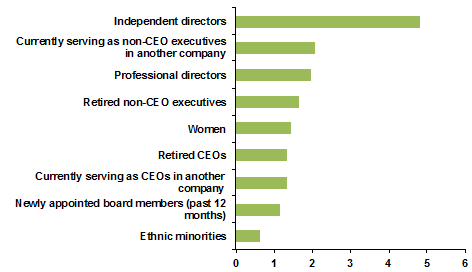 Board Composition.
Board Composition.
Female directors comprise 17% of boards in our sample. 23% of female directors in our survey think that gender was a significant factor in their appointment to their current board directorship. Although more than half of directors do not personally support boardroom diversity quotas (this proportion was higher among male directors), 44% agree or strongly agree that diversity in the company is a priority for the board.

2. What skills are boards looking for?
Directors report that their boards are looking for directors with specific skills. In particular, industry, strategy, and financial expertise top the list of qualities sought by boards. Demonstrating know-how in one of these core domains can help individuals get their feet in the door.
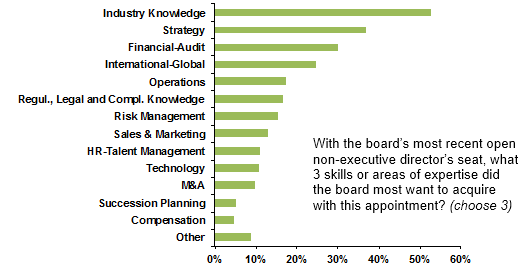 Boards seek directors with specific skill sets.
Boards seek directors with specific skill sets.
Our analysis indicates that there is a need for boards to develop their capabilities in compensation, succession planning, director evaluations, and talent management. Over 60% of boards have strong processes for financial planning, monitoring strategic decisions, and staying current on their industry, while only 33-40% rate their boards’ compensation, succession planning, and talent management processes as above average or excellent. In fact, 22% of directors think that the compensation committee is their boards’ least effective committee, 47% of boards don’t discuss CEO succession regularly at the board level, and more than a third of boards do not conduct performance evaluations of directors.
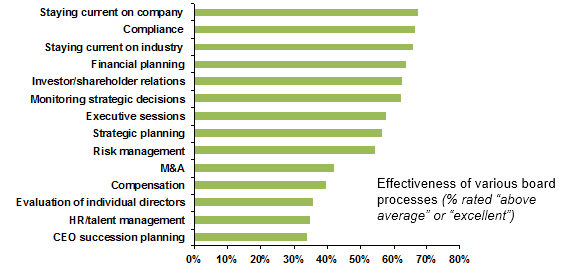 Boards lack strong compensation, talent management, and succession planning processes.
Boards lack strong compensation, talent management, and succession planning processes.
Individuals with specific skill sets that  align with critical board functions have a compelling argument for being added to boards. As one director advised: “Have a clear vision of the role of a director and decide how one matches such a vision. Usually there are gaps in knowledge or experience which ideally should be addressed.”
align with critical board functions have a compelling argument for being added to boards. As one director advised: “Have a clear vision of the role of a director and decide how one matches such a vision. Usually there are gaps in knowledge or experience which ideally should be addressed.”
3. How are directors introduced to the board?
Many board seats are held by current or former executives; however, even independent directors are often familiar with current board members at the time of their appointment: 31% were introduced to their board through the CEO, and 37% were known to at least one of the directors prior to their appointment. Overall, 63% of independent directors were introduced to their boards through either a current executive or board member.
13% of directors were introduced to their boards through an executive search firm, and this proportion is higher for female directors (20%) and for directors of large companies (23%), suggesting that women are recruited to boards through different pathways than men. Some headhunters are asked to specifically recruit female candidates for board seats.
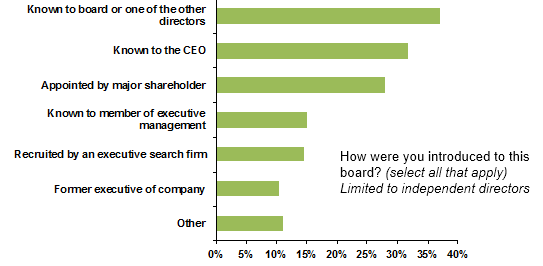 The path to the boardroom goes through insiders.
The path to the boardroom goes through insiders.
4. When do new positions become available?
With director tenures on boards of S&P 500 firms hovering above 8 years, open board seats can be few and far between. Our survey indicates that directors are happy with the size of their boards: 86% of directors think their board is the right size and only 5% think their board is too small. This suggests that average board size is unlikely to change any time soon, and therefore, most openings will arise only when a director leaves the board.
According to our survey, boards appointed an average of 1.2 new directors in the last 12 months. These boards considered an average of 3.6 candidates for their most recent open non-executive director seat (this included, on average, one female candidate and less than one candidate who is an ethnic minority); however, 28% considered just one candidate for the position. To make matters worse, most boards do not manage this process well: only 55% of directors report having an effective succession planning process for directors.
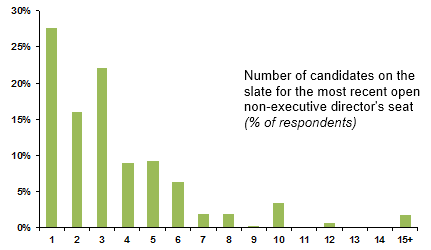 Boards frequently consider just one candidate for open board seats
Boards frequently consider just one candidate for open board seats
Nevertheless, there is some good news for individuals seeking a board appointment. Many boards have implemented policies to ensure regular board turnover: 46% of boards have term limits for directors, while 19% have mandatory retirement ages in place (56% have adopted at least one of these two measures). Directors are generally in favor of these board refreshment policies, so we expect them to become increasingly common in the future.
5. How can you prepare for a directorship?
Aspiring directors can prepare by investing in their networks and connections. Directors in our survey spend an average of 11 hours a month on their professional networks, and an average of 3 hours a month planning and strategizing about their careers. 46% agree or strongly agree that developing their network has been a priority for them and 52% think that many opportunities have come through members of their network. New directors should also be cognizant of a steep learning curve: less than half of directors (49%) agree or strongly agree that their board provides effective training for new directors. A willingness to learn on the job is crucial.
New directors should also be cognizant of a steep learning curve: less than half of directors (49%) agree or strongly agree that their board provides effective training for new directors. A willingness to learn on the job is crucial.
Lastly, potential directors need to be ready for the time commitment: directors dedicate an average of 148 hours toward their board service each year. In addition to the time needed to attend and travel to regular board meetings (directors report having an average of 8 meetings a year), directors also need to carve out time to read and review materials in advance of meetings.
The Path Forward
Individuals aiming to join their first board should focus on developing their professional networks. Most board appointments involve individuals who are already familiar to existing board members, and many boards do not cast a wide net for their recruitment efforts. Although it can be challenging to earn a first board appointment, just one directorship can lead to many more subsequent board opportunities.
Individuals can also work on bolstering their skill sets. Financial acumen and industry expertise are common criteria for directors, and specialized experience related to CEO succession, compensation, and talent management can help boards address deficiencies in their ability to fulfill key board responsibilities.
At the end of the day, aspiring board members should take stock of what they could contribute and gain by serving as a director, and formulate a plan accordingly, keeping in mind that board recruitment efforts are far from perfect. As one director advised, echoing Gandhi: “Learn as though you are going to live forever and live as though you are going to die tomorrow. Try and make it fun. Stay calm in the turbulence.”
Yo-Jud Cheng is a doctoral candidate in the Strategy unit at Harvard Business School. Her research interests focus on succession planning processes and other issues related to strategic human resource management and personnel economics.
Boris Groysberg is the Richard P. Chapman Professor of Business Administration at Harvard Business School. His work examines how a firm can be systematic in achieving a sustainable competitive advantage by leveraging its talent at all levels of the organization.